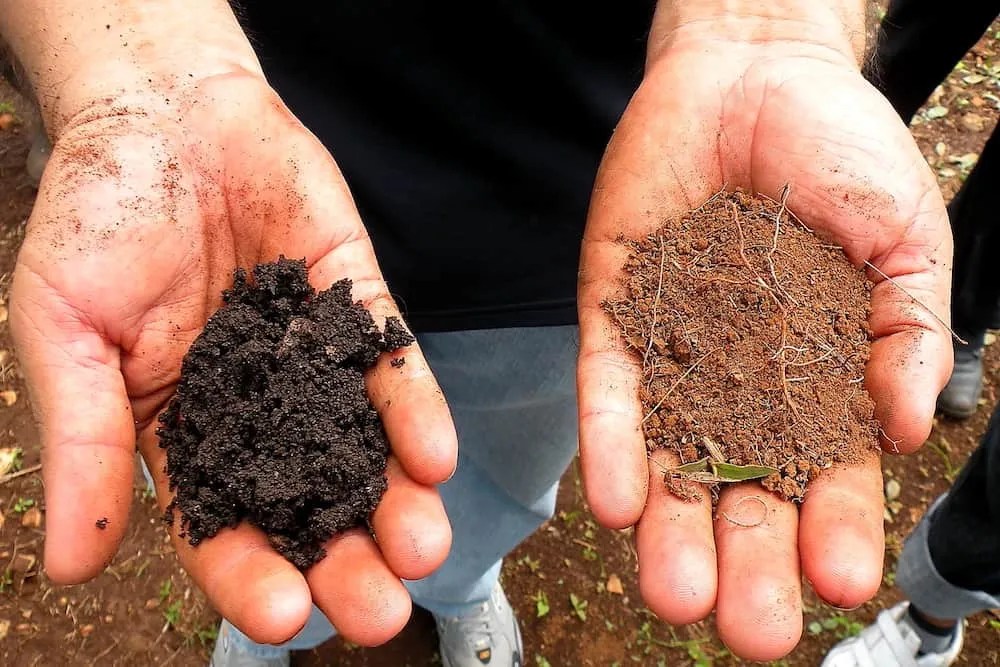Related
Soil plays a massive character in your industrial plant ’s wellness and lifecycle . Soil moisture , on the other mitt , is a double - edged steel with positive and negative effect . If yourplants are often droopy , exanimate , or wilted , your first inherent aptitude is to hold back the soil for moisture .
If your soil is moist , but your plant are n’t felicitous , it means itlacks right drainageor thesoil is compacted . While you canuse a soil wet tester , learning other ways to test soil moisture can aid you prevent root bunkum , mould , and other problems that hail with excessive and low levels .
Understanding Soil Moisture 101
Image credit : Rita Meraki via Shutterstock
If you pull off large gardens , you probably use a garden irrigation system of rules to help your plant thrive . However , excessive irrigation mean higher vigor visor due to the electricity needed to pump water . If you get a line how to measure your soil ’s moisture , you will save water system and cut down on your energy costs . You ’ll want to take maintenance of this consequence rather rather than later .
Excessive dirt moisture can cause :

Conversely , a want of soil moisture :
How To Measure Soil Moisture
Image credits : Alicia Christin Gerald via Unsplash
To control irritation , you ’ll take to learn how to try out your soil ’s moisture floor to interpret how often it ask watering . Here are some efficient ways to measure soil moisture .
Method 1: Gravimetric
This is the most commonly used method of measuring soil wet . Also known as ‘ in - situ instrumentation , ’ it is a direct method that does n’t involve sensors but trust on thermogravimetry . Thermogravimetry is a method used for the speedy analytic thinking of territory characteristics .
Baking tray
Desiccator

treatment tools ( pair of tongs , spoonful , spatula )
boxing glove
Oven

Soil sample ( below 0.22 pound )
Tube auger
Electronic exfoliation

3 - 5 Moisture cans
Somewhere to record your findings
Step-by-Step Method
1. Collect Your Soil Samples With a Tube Auger
epitome credits : Permaculture Association via Creative Commons
Since the hydrometric method bank on soil samples from different location and profundity , use a tube wimble to collect equal samples of moist and dry soil . A tube screw auger is a tool that come with many handles and distance , grant you to take a deep sample of the soil .
That state , they ’re not effective in areas with many rocks . The downside of using a metro screw auger is that while try , you could contaminate unlike types of soils , leading to inaccurate results .

Soil Water Tension (Tensiometers) in vegetable garden
2. Weigh the Moisture Cans and Fill Them With Different Soils
Image credits : Joanna Bourne via Creative Commons
A wet can is a little container sooner made from aluminium or atomic number 50 . Take a spell of composition or a book and pull out four column . Label the first chromatography column as Weight 1 , the 2nd column as Weight 2 , the third column as Weight 3 , and the fourth pillar as Difference .
Weigh the empty moisture cans and record their weighting under Weight 1 to have them as a control variable . After collecting grease sample , put them into your moisture cans , and then weigh the fill cans again . This time , record their exercising weight under Weight 2 .

3. Place the Cans in the Oven
Image credits : cottonbro studio via Pexels
determine your oven to 220 degree Fahrenheit and put the ground - filled bathroom on a baking tray . Leave them inside the oven for 24 hour .
4. Calculate the Amount of Water Lost
effigy credit rating : Queensland State Archives via Creative Commons
After 24 hours in the oven , your territory sample will be teetotal . count your moisture tooshie again and record them under Weight 3 . Now estimate the difference between Weight 2 and Weight 3 and record it under the quaternary editorial titled Difference . This remainder will give you the weight of your grime after piss evaporation .
5. Calculate the Water Content of the Soil
Image credits : Zen Chung via Pexels
The water or moisture content of the grease is expressed as a per centum , and you’re able to calculate it by using this formula :
If you ’re test larger soil sample distribution ( 0.44 pounds or more ) , you ’ll need to shake the soil during the oven - dry out form so it can dry out well . This is of import to have precise mensuration .

Method 2: Tensiometer
Equipped with a vacancy gage , the tensiometer is a nifty pecker that measures soil ’s electronegative pressure or urine suction . This suction is comparable to a plant ’s force when it soak up water from the ground .
Tensiometer
1. Soak Your Tensiometer in Water Before Placing it in the Soil
Image credits : nop16 via Shutterstock
Before you use your tensiometer , soak it in water overnight to satiate the plastic tube with water . think back to place the tensiometer properly to get accurate readings . Place the porous cupful that it come with in the soil at your desired deepness for 24 hours to regurgitate the same force as the water in the stain .
2. Pay Attention to the Vacuum Gauge
As the tensiometer create equilibrium with the soil ’s water pressure , the sucking at the porous point is transferred to the emptiness bore . The suction between the soil and water is measure out in centibars ( cb ) , and the gauge range is from 0 to 0.8 .
If it progress to the 0.8 grade ( 80 cb ) , the force has crossed a point in time of no payoff because the suck and urine molecules have secern . This render the tensiometer unusable because zephyr can enter the tube through the porous tip .
3. Interpret the Gauge Reading
For moist soils , the readings entail the pursual :
0 cb
The soil is saturated to the point where plant ascendant will stick out from poor aeration and infection from waterlogging .

10 to 25 cb
The soil is at field electrical capacity . A downcast reading show flaxen ground , and gamey reading indicates finer filth .
70 to 80 cb

The grease is wry .
For silt andclay soils , you ’ll need a tensiometer with a higher kitchen range ( 80 cb to 110 cb ) .
Method 3: Gypsum Blocks
electric resistance city block or gypsum blocks are made of two electrode incase in a porous substance called gypsum . Gypsum is a chemical compound that contains calcium and S .
Also have-to doe with to as wet block , the electrodes have two lead conducting wire stay put out of the soil while the measurement is performed .
Gypsum orelectrical opposition blocks

Voltage author
1. Place Your Resistance Block in the Soil
Image credits : Irrometer via Amazon
Much like a tensiometer , the moisture blocks measure dirt water system suction after you submerge it at a specific layer in the filth and recreate the suck of the hem in soil . The overarching principle is that water conducts electrical energy . So , if the soil ’s moisture variety , so does the moisture cognitive content in the block .
As the electrical resistance of the two electrode increases , the water content in the moisture jam decrement .

2. Collect and Interpret Reading
Image credits : Los Muertos Crew via Pexels
To get a reading of the grime water content , relate the lead wires to a resistance meter with the range 0 to 100 or 0 to 200 . by and large , low meter readings stand for low levels of soil - piddle , and gamy readings indicate high levels of grease - water supply .
Method 4: Assessing Appearance and Feel
The last method is on the face of it the most obvious ; however , it demand a lot of skill to assess the soil ’s moisture in effect by feel it . Likely led by intuition , this method acting is simple and can help break a hypothesis about your soil ’s moisture before implementing other elaborate measurement method .
A jigaboo or land probe
A sound good sense of survey and touch

0.0 in./ft .
0.2 in./ft .
0.4 in./ft .

Soil Water Tension (Tensiometers) in vegetable garden
0.6 in./ft .
0.8 in./ft .
1.0 in./ft .

Soil Water Tension (Tensiometers) in vegetable garden
1.2 in./ft .
1.4 in./ft .
1.6 in./ft .

Soil Water Tension (Tensiometers) in vegetable garden
1.8 in./ft .
2.0 in./ft .
2. Feel the Soil, Assess its Appearance, and Compare to Gauge Soil Moisture
Image credits : Zoe Scaeffer via Unsplash
According to research by Colorado State University , the hand - feel estimation can be off by 10 percent or more . However , theUSDA Natural Resources Conservation Servicehas get a guide to help you estimate moisture want by feel and appearance at various horizontal surface of soil samples .
This templet has description for the tone and appearance of loamy , flaxen , and clay land at the various levels , which you may interpret and equate as a benchmark to help pinpoint your stain ’s moisture storey .

Lettuce Talk Dirt!
Who would ’ve thought that measuring grease wet could be simple yet so elaborate ? Of naturally , you could rely on the garden soil examiner or the Graeco-Roman look - and - feel method acting , but the more proficient methods have more truth to provide .
Within the technical method , you could opt for the more experimental hydrometric method acting or keep it simple with a tensiometer reading material ; either way , you should peck the method that will meet your territory ’s need .
result your experiences , intellection , and questions in the comment part ! And divvy up with friends and family who might find this helpful .

felicitous horticulture !
